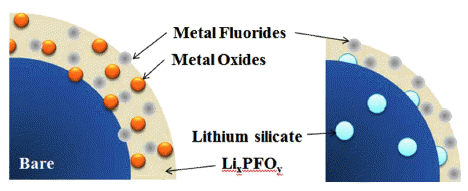- [English]
- Lithium-silicate coating on Lithium Nickel Manganese Oxide (LiNi0.7Mn0.3O2) with a Layered Structure
-
Dong-jin Kim, Da-ye Yoon, Woo-byoung Kim, Jae-won Lee
-
J Korean Powder Metall Inst. 2017;24(2):87-95. Published online April 1, 2017
-
DOI: https://doi.org/10.4150/KPMI.2017.24.2.87
-
-
1,034
View
-
6
Download
-
1
Citations
-
 Abstract Abstract
 PDF PDF
Lithium silicate, a lithium-ion conducting ceramic, is coated on a layer-structured lithium nickel manganese oxide (LiNi0.7Mn0.3O2). Residual lithium compounds (Li2CO3 and LiOH) on the surface of the cathode material and SiO2 derived from tetraethylorthosilicate are used as lithium and silicon sources, respectively. Powder X-ray diffraction and scanning electron microscopy with energy-dispersive spectroscopy analyses show that lithium silicate is coated uniformly on the cathode particles. Charge and discharge tests of the samples show that the coating can enhance the rate capability and cycle life performance. The improvements are attributed to the reduced interfacial resistance originating from suppression of solid-electrolyte interface (SEI) formation and dissolution of Ni and Mn due to the coating. An X-ray photoelectron spectroscopy study of the cycled electrodes shows that nickel oxide and manganese oxide particles are formed on the surface of the electrode and that greater decomposition of the electrolyte occurs for the bare sample, which confirms the assumption that SEI formation and Ni and Mn dissolution can be reduced using the coating process. -
Citations
Citations to this article as recorded by  - Artificial cathode-electrolyte interphases on nickel-rich cathode materials modified by silyl functional group
Hye Ji Song, Seol Heui Jang, Juhyeon Ahn, Si Hyoung Oh, Taeeun Yim
Journal of Power Sources.2019; 416: 1. CrossRef
- [Korean]
- Synthesis of Fine Copper Powders from CuO-H2O Slurry by Wet-reduction Method
-
Jong-Gwan Ahn, Dong-Jin Kim, Ik-Kyu Lee, Jaeryeung Lee, Liang Huanzhen
-
J Korean Powder Metall Inst. 2005;12(3):192-200.
-
DOI: https://doi.org/10.4150/KPMI.2005.12.3.192
-
-
 Abstract Abstract
 PDF PDF
- Ultrafine copper powder was prepared from CuO-H_2O slurry with hydrazine, a reductant, under 70°C. The influence of various reaction parameters such as temperature, reaction time, molar ratio of N_2H_4, PvP and NaOH to Cu in aqueous solution had been studied on the morphology and powder phase of Cu powders obtained. The production ratio of Cu from CuO was increased with the ratio of N_2H_4/Cu and the temperature. When the ratio of N_2H_4/Cu was higher than 2.5 and the temperature was higher than 60°C, CuO was completely reduced into Cu within 40 min. The crystalline size of Cu obtained became fine as the temperature increase, whereas the aggregation degree of particles was increased with the reaction time. The morphology of Cu powder depended on that of the precursor of CuO and processing conditions. The average particle size was about 0.5µm.
- [Korean]
- Synthesis of Flake Ag Powder by Polyol Process
-
Dong-Jin Kim, Huanzhen Liang, Jong-Gwan Ahn, Jae-Ryeong Lee, Hun-Saeng Chung
-
J Korean Powder Metall Inst. 2004;11(6):477-485.
-
DOI: https://doi.org/10.4150/KPMI.2004.11.6.477
-
-
 Abstract Abstract
 PDF PDF
- Monodispersed flaky silver powder was obtained by controlling the ratios of H_2O_2/NH_3 and Agin in a mixed solution of ethylene glycol and ammonia with an addition of PVP. The effects of NH_3/Ag,; H_2O_2/Ag;and;H_2PtCl_6/Ag on its morphology and size were investigated. In H_2O_2-NH_3-AgNO_3;system,;NH_3/Ag molar ratio was found to be an important reaction factor for the nucleation and crystal growth of Ag powder. The synthesis of flaky powder was optimized at over 6 of NH_3/Ag ;and;5;of;H_2O_2/Ag;under;1.0times10-3;of;Pt/Ag.;Moreover,;as;the; NH_3/Ag molar ratio increased, the size of precipitates was increased regardless of the amount of Pt. In the absence of H_2PtCI, the morphology and size of reduced Ag powder were found to be irregular in shape 2-4µm in diameter. However, homogenized fine Ag powder was obtained due to heterogeneous nucleation when H_2PtCI used as a cat-alyst, and flaky one was synthesized with the addition of Pt over 1.0times10-3 of Pt/Ag.
|





